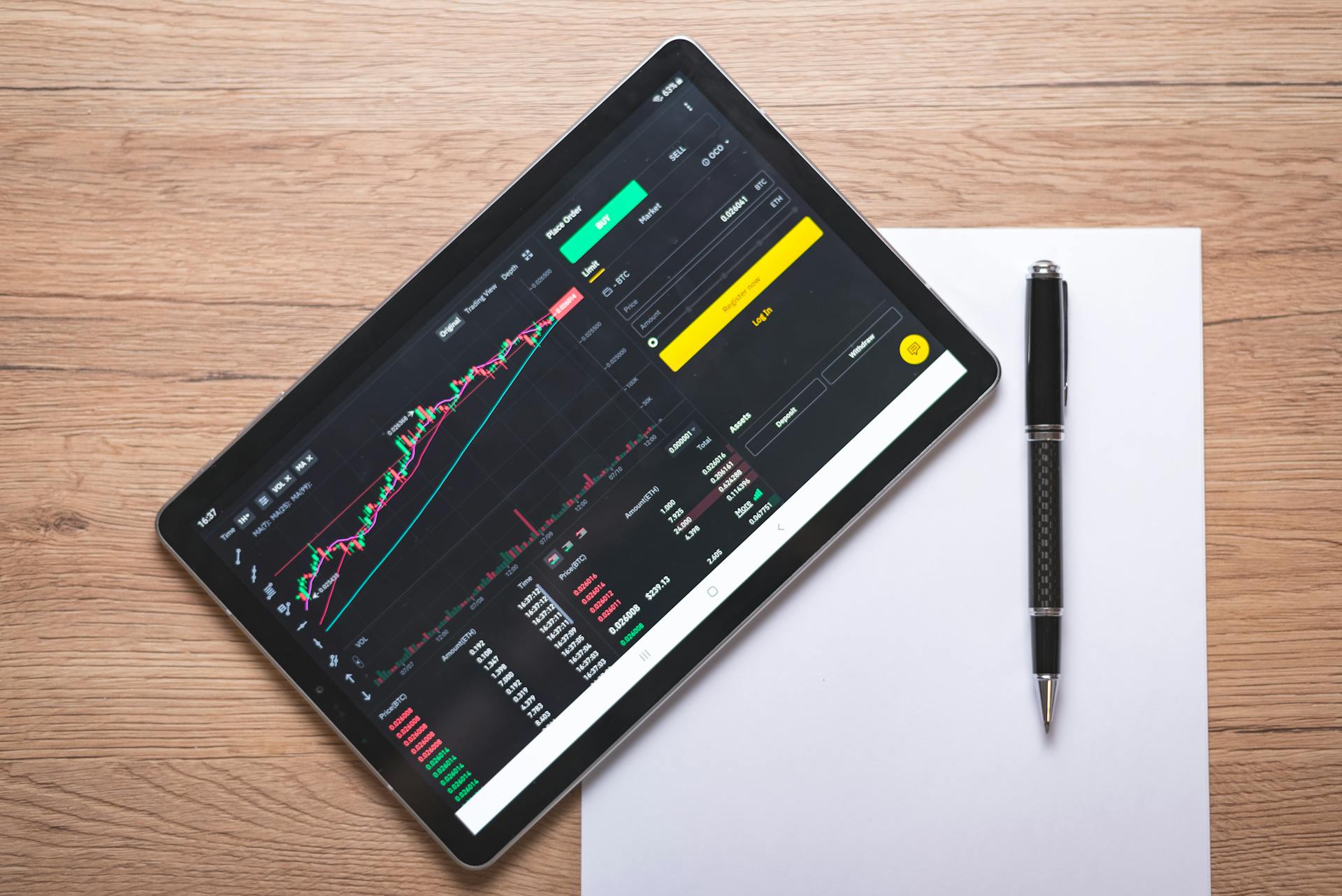
Preferred shares yield is a way to measure the return on investment for preferred shareholders. It's calculated by dividing the annual dividend payment by the par value of the preferred share.
The yield is typically expressed as a percentage, making it easy to compare with other investments. For example, if a preferred share pays a $5 annual dividend and has a par value of $100, the yield would be 5%.
Preferred shareholders receive a fixed dividend payment at regular intervals, usually quarterly or annually. This predictable income stream is one of the key benefits of investing in preferred shares.
Understanding Preferred Shares Yield
Preferred shares yield is a measure of the return on investment, calculated by dividing the annual expected dividend by the stock's current market price. This results in a percentage that represents the number of dividends a shareholder will receive for every dollar invested.
The yield on preferred shares is typically higher than on common stocks because preferred shares offer a higher annual dividend per share. For example, assume the common stock of XYZ Inc. pays an annual dividend of $0.50 per share, and the current stock price is $15 per share. The yield on this stock is currently 3.33% ($0.50/$15).
The higher dividend on preferred shares is often a trade-off for the lack of price appreciation and voting rights. This means that investors who prioritize dividend income may find preferred shares to be an attractive option, but those who seek price growth may prefer common stocks.
Here's a comparison of the features of preferred and common stocks:
Yield
Yield is a crucial aspect of preferred shares, and it's essential to understand how it works. Investors in preferred stocks generally know in advance how much they'll earn, because the dividend is paid at a fixed rate.
The fixed interest rate is a percentage of a fixed value (the par value) for the preferred share. This means that preferred shareholders can expect a predictable income stream.
Common stocks, on the other hand, have no such yield guarantees. Dividends are never guaranteed on common shares. However, they also have no structural cap on how much yield they can generate.
Common dividends can be raised at any time, making them a potentially attractive option for investors seeking higher returns. The yield and price growth of a common stock is affected by the performance of the underlying company and by general market conditions.
The yield on a preferred stock is calculated by taking the stock's annual expected dividend and then dividing that number by the stock's current market price. This results in a coefficient that is usually expressed in percentage terms.
A higher dividend per share can result in a higher yield for preferred stocks. However, this privilege comes with some drawbacks, including the loss of voting rights and less chance for price appreciation.
Capital Stack Seniority
In the event of a company's financial difficulties, the capital stack seniority comes into play. This determines the order in which different types of investors are paid back if the company is liquidated or goes bankrupt.
Lenders and creditors typically have the most seniority, meaning they get paid first. This is because they have a direct claim on the company's assets.
Preferred stock holders come next, but only after creditors have been paid. They have seniority over common shareholders, who are at the bottom of the capital stack.
This is why preferred stock holders can still be affected by extreme circumstances, such as a company facing a cash crunch or bankruptcy. In such cases, the company may suspend dividend payments on preferred shares.
Here's a quick summary of the capital stack seniority:
This hierarchy is important to understand when investing in preferred shares, as it can impact the potential returns on your investment.
Stock's Track Record
Preferred stocks have a unique track record, particularly during times of financial crisis. In 2022 and 2023, the regional banking crisis led to sharp declines in preferred stock prices, some of the sharpest since the 2008 financial crisis.
The iShares Preferred & Income Securities ETF (PFF) outperformed the iShares 20+ Year Treasury Bond ETF (TLT) in 2023, rising 0.66% while the latter dropped 9.45%. This is a testament to the resilience of preferred stocks.
Higher interest rates led to a predictable drop in bond prices, but already-depressed preferred stock prices helped buffer the impact.
Factors Affecting Preferred Shares Yield
Preferred shares yield can be affected by the company's credit rating, which can impact the interest rate offered on the preferred shares. A lower credit rating can result in a lower yield.
The yield on preferred shares can also be influenced by the dividend payout ratio, which is the percentage of earnings paid out to shareholders. This ratio can vary significantly between companies.
A higher dividend payout ratio can lead to a lower yield on preferred shares, as a larger portion of earnings is being distributed to shareholders.
Investing in Preferred Shares Yield
Preferred shares yield can provide an attractive source of income for retirement, offering yields that are often higher than those found in comparable bonds.
They also typically come with a good credit quality, making them a relatively safe investment.
Individual preferred shares can be purchased at a reasonable price, with a modest face value of around $25.
This makes them more accessible to retail investors than individual bonds.
The stable face value of preferred shares creates a bond-like fixed payment, rather than a variable dividend.
And, unlike conventional bond payments, preferred shares usually pay qualified dividends that fall under a lower tax rate than ordinary income.
Preferred Shares Yield vs. Other Investments
Preferred shares yield is attractive, with most income investors seeking a steady source of income for retirement. Preferred stock offers yields that are hard to find in comparable bonds.
The stable face value of preferred stock creates a bond-like fixed payment, which is a major advantage over traditional dividend stocks. Unlike conventional bond payments, preferred stocks usually pay qualified dividends that fall under a lower tax rate than ordinary income.
Investing in preferred stock has a similar risk profile to bond investing, so you won't receive an expected yield if the company that issued the preferred stock declares bankruptcy.
Stocks vs. Bonds
Preferred shares offer a unique investment opportunity that often flies under the radar. They combine elements of both stocks and bonds, making them an attractive option for income investors.
One of the key benefits of preferred shares is their fixed rate of return, which is similar to a bond's coupon payment. This provides a predictable source of income, which is especially important for retirees or those living on a fixed income.
In terms of risk, investing in preferred shares has a similar profile to bond investing. This means that investors may not receive their expected yield if the company that issued the preferred shares declares bankruptcy.
Preferred shares are often considered a hybrid security, combining the benefits of both stocks and bonds. They come with a face value, usually modest, and pay a fixed dividend on a regular basis.
Unlike conventional bonds, preferred shares typically pay qualified dividends that fall under a lower tax rate than ordinary income. This can be a significant advantage for investors looking to minimize their tax liability.
In terms of maturity, preferred shares often have very long maturities, sometimes even perpetual. This means that investors may be holding onto their shares for an extended period of time, making them more sensitive to changes in interest rates.
To give you a better idea, here are some key characteristics of popular preferred share ETFs:
These ETFs offer a range of options for investors, including fixed and floating rate preferred shares, and varying levels of portfolio diversification.
Stock vs. Stock
If you're considering investing in preferred shares, it's essential to understand how they compare to common stock.
Preferred stock has a fixed yield, which means you can expect a steady return on your investment. Common stock, on the other hand, has a variable yield.
In terms of capital stack seniority, preferred stock is senior, meaning it gets paid out first in the event of a liquidation. Common stock is junior, with a lower claim on assets.
One key difference between preferred and common stock is voting rights. Preferred stockholders have none, whereas common stockholders get one vote per share.
The pricing of preferred stock is often determined using the dividend discount model, whereas common stock is priced based on market forces.
Preferred stock typically has low price growth potential and price volatility, making it a more stable investment. Common stock, by contrast, has moderate to high price growth potential and price volatility.
In terms of liquidity, preferred stock is generally less liquid than common stock, with moderate to low marketability.
Frequently Asked Questions
What does 7% preferred stock mean?
7% preferred stock refers to a type of stock that pays a fixed annual dividend of 7% of its par value, typically $70 in this case. This means the investor receives a predictable income stream, similar to a bond
What is the average return on preferred stocks?
Preferred stocks typically yield between 6% and 9% annually. This relatively stable return can be a valuable addition to income investors' portfolios.
Do preferred shares have higher dividends?
Preferred shares typically have higher dividend payments than common stock. These dividends are often paid out before common stock dividends.
Sources
- https://www.britannica.com/money/preferred-stock-vs-common-stock
- https://www.investopedia.com/ask/answers/07/higherpreferredyield.asp
- https://www.morningstar.ca/ca/news/185441/are-preferred-stocks-your-best-choice.aspx
- https://www.dividend.com/fixed-income-channel/should-you-look-at-preferred-stock-for-yield/
- https://www.kiplinger.com/investing/602804/preferred-stock-should-i-buy-it
Featured Images: pexels.com


